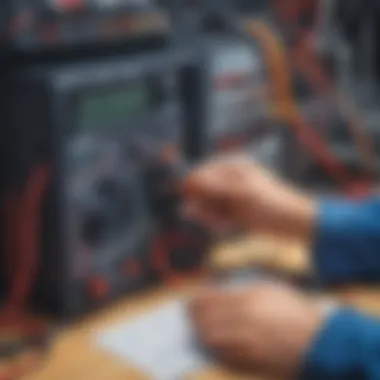Mastering Voltage Measurement Techniques with a Multimeter


Discover the Wonders of Science
Science Experiment Showcase
Step 1: Setting Up the Multimeter
To commence our experiment, we first focus on setting up the multimeter for voltage measurement. Adjusting the selector knob to the voltage (V) setting, we ensure accuracy and precision in our readings. This crucial step lays the foundation for reliable measurements, guaranteeing a seamless testing process that yields valuable insights into the electrical properties under examination.
Step 2: Connecting the Probes
With the multimeter prepared, we proceed to connect the probes to the circuit or component under analysis. The red probe is delicately attached to the positive terminal, while the black probe is securely fastened to the negative terminal. By establishing a direct connection, we enable the multimeter to capture the voltage across the circuit, preparing for detailed observations vital for comprehensive electrical testing.
Step 3: Taking the Measurement
As the probes are in position, we are poised to take the voltage measurement. Keeping a close watch on the multimeter display, we note the readings with precision and accuracy. By interpreting these values attentively, we gain insights into the voltage levels present within the circuit, unraveling critical information for diagnostic purposes and system optimization.
Step 4: Ensuring Safety Measures
Throughout the experiment, safety remains paramount. Adhering to safety tips and precautions ensures a secure testing environment, mitigating risks and hazards associated with electrical measurements. By prioritizing safety measures, we demonstrate responsible conduct and respect for the principles of safe experimentation, fostering a culture of caution and preparedness in scientific pursuits.
Synthesizing the Information
Introduction
What is Voltage?
Definition of voltage


Voltage, in its essence, represents the electrical potential difference between two points in a circuit. This metric, expressed in volts, dictates the force driving electric current through a conductor. Understanding the definition of voltage is pivotal as it unveils the driving force behind electrical flow, elucidating the very foundation of electrical phenomena. Voltage, akin to the pressure in a fluid system, signifies the energy per unit charge available to move electrons, defining the core aspect of electrical circuits within this article.
Importance of voltage in electrical systems
The significance of voltage in electrical systems cannot be overstated, serving as the lifeline of power transmission. Voltage is the impetus that propels electricity from its source to various components, ensuring the efficient operation of electronic devices. Its paramount importance lies in dictating the performance and safety of electrical systems, making it a critical facet of electrical engineering. Understanding the role of voltage within electrical systems is imperative for maintaining stability and safeguarding equipment from potential damage.
Role of Multimeter
Overview of multimeter functionality
A multimeter embodies a versatile instrument designed for a myriad of electrical measurements, including voltage, current, and resistance. Its functionality extends to both professional and amateur usage, offering a comprehensive solution for diagnosing electrical issues. The overview of multimeter functionality elucidates its capability to measure voltage accurately, catering to the diverse needs of electrical enthusiasts. The multimeter's innate ability to provide precise readings renders it indispensable in the domain of electrical testing.
Types of multimeters
Diverse in nature, multimeters come in various types tailored for specific applications, such as digital, analog, and specialized variants. Each type offers distinct features and benefits, catering to different user requirements. Digital multimeters, with their user-friendly interfaces and precise measurements, have gained popularity in modern setups. Analog multimeters, though less common today, hold relevance for certain analog circuit assessments. Specialized multimeters cater to niche tasks, showcasing the adaptability and versatility of multimeter devices within the electrical measurement domain.
Understanding Voltage Measurement
Voltage Measurement Basics
Voltage units
Voltage units, such as volts (V), provide a standardized measurement for electrical potential difference. Volts are essential in quantifying the energy transferred per unit charge in an electrical circuit. The precise measurement of voltage enables technicians to analyze circuit behavior, identify faults, and make informed decisions regarding system operation. Utilizing voltage units effectively allows for the accurate assessment of electrical parameters, facilitating optimal performance and safety.
Measurement range
The measurement range refers to the span within which a multimeter can detect and display voltage levels. Understanding the measurement range is crucial for selecting the appropriate settings to avoid measurement errors or equipment damage. By interpreting the measurement range correctly, users can ensure that the multimeter can capture the voltage being tested accurately. Matching the measurement range with the expected voltage value enhances measurement precision and reduces the risk of misleading readings, fostering reliable electrical diagnostics and troubleshooting efforts.


Setting Up the Multimeter
Selecting the appropriate voltage range
Selecting the appropriate voltage range on a multimeter involves choosing the setting that accommodates the expected voltage level. This selection ensures that the multimeter can accurately measure and display the voltage without overloading its circuits. By aligning the voltage range with the anticipated voltage reading, users prevent equipment malfunctions and safeguard against inaccurate measurements. Properly selecting the voltage range optimizes measurement accuracy and enhances the effectiveness of electrical testing procedures.
Adjusting settings for accurate measurement
Adjusting settings for accurate measurement involves configuring the multimeter to reflect the specific requirements of the electrical test being conducted. By setting the measurement parameters correctly, users can obtain precise voltage readings and avoid errors in data interpretation. Accurate adjustments enhance the reliability of test results and promote the efficient identification of electrical issues. Ensuring that settings are appropriately adjusted permits seamless voltage measurement and contributes to a thorough analysis of electrical systems.
Safety Precautions
Importance of safety measures
Emphasizing safety measures in voltage measurement activities is paramount to prevent accidents and injuries. Integrating safety protocols into electrical work environments establishes a secure testing environment and minimizes risks associated with voltage exposure. Prioritizing safety measures promotes awareness and responsible practices among technicians, fostering a culture of caution and preparedness in electrical testing scenarios. Adhering to safety guidelines enhances personal well-being and sustains the integrity of equipment and facilities.
Avoiding electric shocks
Mitigating the risk of electric shocks is a critical safety consideration when engaging in voltage measurement tasks. Electric shocks pose significant hazards to individuals and can lead to severe injuries or fatalities. By implementing protective measures and following best practices, such as using insulated tools and maintaining dry conditions, individuals can reduce the likelihood of electrical accidents. Preventing electric shocks safeguards against harm and ensures a secure working environment conducive to accurate and reliable voltage measurements.
Measuring Voltage
Step-by-Step Guide
Connecting the Multimeter Probes
Connecting the multimeter probes stands as a pivotal initial step in the voltage measurement process. By linking the probes correctly to the circuit under examination, technicians pave the way for accurate and reliable voltage readings. The key characteristic of connecting the multimeter probes lies in its simplicity yet critical role in establishing a direct pathway for measuring voltage. Despite its seemingly straightforward nature, the correct connection of probes greatly influences the accuracy of the measurements made. The benefit of this step within the context of this article lies in its fundamental nature, setting the stage for precise voltage assessment without room for error.


Reading the Voltage Display
Once the multimeter probes are securely connected, the next focus shifts to deciphering the voltage display. Whether digital or analog, the voltage output showcased on the multimeter screen provides critical information regarding the electrical potential within the circuit. Understanding the key characteristic of reading the voltage display is paramount for accurately interpreting the measurement obtained. The advantage of this aspect within this article lies in its role as the final output of the measurement process, consolidating the information gathered into a tangible value easily comprehensible by technicians and enthusiasts alike.
Interpreting Results
Understanding Voltage Readings
Unraveling the intricacies of voltage readings unlocks invaluable insights into the health and functionality of electrical systems. Understanding voltage readings involves grasping the numerical values displayed and evaluating them in relation to the expected range for the specific circuit. The distinguishing characteristic of this aspect lies in its capacity to reveal discrepancies or irregularities within the system, guiding towards potential areas of concern or improvement. This beneficial versatility of understanding voltage readings in this article aids in a comprehensive assessment of the electrical landscape under observation.
Troubleshooting Based on Results
The ability to troubleshoot based on voltage measurement results constitutes a proactive approach towards maintaining optimal electrical performance. By analyzing the voltage readings obtained, technicians can identify and address underlying issues affecting system performance. The key advantage of troubleshooting based on results is its diagnostic power, allowing for targeted interventions and solutions to rectify inefficiencies or faults. Intertwined with the overarching goal of this article, troubleshooting based on results serves as a practical application of the measured data, facilitating actionable steps towards system enhancement.
Additional Tips
Calibrating the Multimeter
Calibrating the multimeter is a crucial practice to ensure the accuracy and reliability of voltage measurements. The key characteristic of calibrating the multimeter lies in fine-tuning its internal settings to align with established standards, enhancing the precision of readings obtained. The benefit of this practice within this article stems from its role in optimizing the multimeter's performance, guaranteeing trustworthy data for informed decision-making.
Recording Measurements
Recording measurements serves as a strategic approach in documentation and analysis, offering a tangible reference point for future assessments or comparisons. The unique feature of recording measurements lies in its capacity to preserve crucial data for retrospective review and trend analysis. By documenting voltage readings systematically, technicians can track changes over time, enabling a comprehensive understanding of system dynamics and performance trends within the scope of this article.
Conclusion
Key Takeaways
- Significance of Accurate Voltage Measurement: Precision in voltage measurement is paramount to diagnosing and resolving electrical issues effectively. Within this article, the meticulous attention to accurate readings ensures that faults can be pinpointed and rectified with confidence. Emphasizing accurate voltage measurement underscores the foundation of reliable electrical maintenance practices, safeguarding both equipment and individuals operating within the system.
- Enhancing Electrical Knowledge: Delving into voltage measurement with a multimeter enhances one's overall comprehension of electrical systems. By grasping the finer points of measuring voltage, individuals not only expand their technical skills but also cultivate a deeper understanding of how electricity behaves in various scenarios. This knowledge empowers individuals to troubleshoot efficiently and make informed decisions for maintaining electrical integrity.
Future Applications
- Applying Voltage Measurement Skills: The ability to measure voltage accurately translates into a practical skill applicable across diverse electrical settings. Whether in a residential, commercial, or industrial context, the proficiency in voltage measurement equips individuals to tackle electrical challenges confidently. This skill serves as a foundational step towards a deeper engagement with electrical systems, promoting safety and efficiency.
- Exploring Advanced Multimeter Functions: Advancing beyond basic voltage measurement opens doors to exploring the full capabilities of a multimeter. By understanding and utilizing the advanced functions of this tool, individuals can conduct more comprehensive electrical assessments and diagnostics. Exploring these features not only enhances measurement accuracy but also broadens the scope of electrical troubleshooting, enabling a more profound analysis of complex electrical systems.







